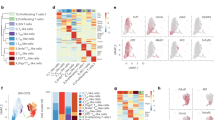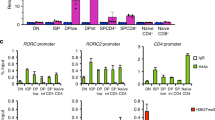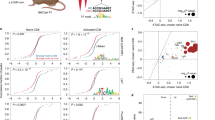Abstract
Several regulatory regions are important for the expression of genes encoding T helper type 2 (TH2) cytokines, including TH2-specific DNase I hypersensitivity sites in the TH2 cytokine locus control region. Among these sites, Rad50 hypersensitive site 7 (RHS7) shows rapid TH2-specific demethylation after antigenic stimulation. To investigate the function of RHS7 in TH2 cell differentiation, we have generated RHS7-deficient mice. CD4+ T cells and mast cells showed a notable reduction in TH2 cytokine expression in vitro and TH2 responses in vivo were considerably impaired in RHS7-deficient mice. Deletion of RHS7 did not affect the expression of a linked Rad50 gene, but it did reduce long-range intrachromosomal interactions between the locus control region and promoters of the TH2 cytokine genes. Our findings show that RHS7 is essential for the proper regulation of TH2 cytokine gene expression.
This is a preview of subscription content, access via your institution
Access options
Subscribe to this journal
Receive 12 print issues and online access
$209.00 per year
only $17.42 per issue
Buy this article
- Purchase on Springer Link
- Instant access to full article PDF
Prices may be subject to local taxes which are calculated during checkout







Similar content being viewed by others
References
Abbas, A.K., Murphy, K.M. & Sher, A. Functional diversity of helper T lymphocytes. Nature 383, 787–793 (1996).
Dong, C. & Flavell, R.A. TH1 and TH2 cells. Curr. Opin. Hematol. 8, 47–51 (2001).
Glimcher, L.H. & Murphy, K.M. Lineage commitment in the immune system: the T helper lymphocyte grows up. Genes Dev. 14, 1693–1711 (2000).
O'Garra, A. & Arai, N. The molecular basis of T helper 1 and T helper 2 cell differentiation. Trends Cell Biol. 10, 542–550 (2000).
Ansel, K.M., Lee, D.U. & Rao, A. An epigenetic view of helper T cell differentiation. Nat. Immunol. 4, 616–623 (2003).
Smale, S.T. & Fisher, A.G. Chromatin structure and gene regulation in the immune system. Annu. Rev. Immunol. 20, 427–462 (2002).
Agarwal, S. & Rao, A. Modulation of chromatin structure regulates cytokine gene expression during T cell differentiation. Immunity 9, 765–775 (1998).
Bird, J.J. et al. Helper T cell differentiation is controlled by the cell cycle. Immunity 9, 229–237 (1998).
Takemoto, N. et al. TH2-specific DNase I-hypersensitive sites in the murine IL-13 and IL-4 intergenic region. Int. Immunol. 12, 1981–1985 (1998).
Lee, D.U., Agarwal, S. & Rao, A. TH2 lineage commitment and efficient IL-4 production involves extended demethylation of the IL-4 gene. Immunity 16, 649–660 (2002).
Fields, P.E., Kim, S.T. & Flavell, R.A. Cutting edge: changes in histone acetylation at the IL-4 and IFN-γ loci accompany TH1/TH2 differentiation. J. Immunol. 169, 647–650 (2002).
Avni, O. et al. TH cell differentiation is accompanied by dynamic changes in histone acetylation of cytokine genes. Nat. Immunol. 3, 643–651 (2002).
Yamashita, M. et al. Identification of a conserved GATA3 response element upstream proximal from the interleukin-13 gene locus. J. Biol. Chem. 277, 42399–42408 (2002).
Makar, K.W. et al. Active recruitment of DNA methyltransferases regulates interleukin 4 in thymocytes and T cells. Nat. Immunol. 4, 1183–1190 (2003).
Loots, G.G. et al. Identification of a coordinate regulator of interleukins 4, 13, and 5 by cross-species sequence comparisons. Science 288, 136–140 (2000).
Mohrs, M. et al. Deletion of a coordinate regulator of type 2 cytokine expression in mice. Nat. Immunol. 2, 842–847 (2001).
Agarwal, S., Avni, O. & Rao, A. Cell-type-restricted binding of the transcription factor NFAT to a distal IL-4 enhancer in vivo. Immunity 12, 643–652 (2000).
Solymar, D.C. et al. A 3′ enhancer in the IL-4 gene regulates cytokine production by TH2 cells and mast cells. Immunity 17, 41–50 (2002).
Lee, G.R., Fields, P.E. & Flavell, R.A. Regulation of IL-4 gene expression by distal regulatory elements and GATA-3 at the chromatin level. Immunity 14, 447–459 (2001).
Lee, G.R., Fields, P.E., Griffin, T.J., IV & Flavell, R.A. Regulation of the TH2 cytokine locus by a locus control region. Immunity 19, 145–153 (2003).
Grosveld, F., van Assendelft, G.B., Greaves, D.R. & Kollias, G. Position-independent, high-level expression of the human β-globin gene in transgenic mice. Cell 51, 975–985 (1987).
Milot, E. et al. Heterochromatin effects on the frequency and duration of LCR-mediated gene transcription. Cell 87, 105–114 (1996).
Fields, P.E., Lee, G.R., Kim, S.T., Bartsevich, V. & Flavell, R.A. Chromatin domains and enhancer activity identify functional components of the TH2 cytokine locus control region. Immunity (in the press).
Spilianakis, C.G. & Flavell, R.A. Long range intrachromosomal interactions in the T helper type 2 cytokine locus. Nat. Immunol. 5, 1017–1027 (2004).
Dekker, J., Rippe, K., Dekker, M. & Kleckner, N. Capturing chromosome conformation. Science 295, 1306–1311 (2002).
Bird, A.P. & Wolffe, A.P. Methylation-induced repression—belts, braces, and chromatin. Cell 99, 451–454 (1999).
Attwood, J.T., Yung, R.L. & Richardson, B.C. DNA methylation and the regulation of gene transcription. Cell. Mol. Life Sci. 59, 241–257 (2002).
Ehrlich, M. DNA methylation in cancer: too much, but also too little. Oncogene 21, 5400–5413 (2002).
Fitzpatrick, D.R. & Wilson, C.B. Methylation and demethylation in the regulation of genes, cells, and responses in the immune system. Clin. Immunol. 109, 37–45 (2003).
Bruniquel, D. & Schwartz, R.H. Selective, stable demethylation of the interleukin-2 gene enhances transcription by an active process. Nat. Immunol. 4, 235–240 (2003).
Tolhuis, B. et al. Looping and interaction between hypersensitive sites in the active β-globin locus. Mol. Cell 10, 1453–1465 (2002).
Palstra, R.J. et al. The β-globin nuclear compartment in development and erythroid differentiation. Nat. Genet. 35, 190–194 (2003).
Carter, D. et al. Long-range chromatin regulatory interactions in vivo. Nat. Genet. 32, 623–626 (2002).
Patrinos, G.P. et al. Multiple interactions between regulatory regions are required to stabilize an active chromatin hub. Genes Dev. 18, 1495–1509 (2004).
Epner, E. et al. The β-globin LCR is not necessary for an open chromatin structure or developmentally regulated transcription of the native mouse β-globin locus. Mol. Cell 2, 447–455 (1998).
Reik, A. et al. The locus control region is necessary for gene expression in the human β-globin locus but not the maintenance of an open chromatin structure in erythroid cells. Mol. Cell. Biol. 18, 5992–6000 (1998).
Bender, M.A., Bulger, M., Close, J. & Groudine, M. β-Globin gene switching and DNase I sensitivity of the endogenous β-globin locus in mice do not require the locus control region. Mol. Cell 5, 387–393 (2000).
Reiner, S.L., Zheng, S., Corry, D.B. & Locksley, R.M. Constructing polycompetitor cDNAs for quantitative PCR. J. Immunol. Methods 165, 37–46 (1993).
Acknowledgements
We thank L. Evangelisti, C. Hughes and J. Stein for assisting with the generation of RHS7-deficient mice; P.E. Fields, S.T. Kim and E. Eynon for discussion; and F. Manzo for help with manuscript preparation. Supported by the National Institutes of Health (HL56389 to R.A.F.), Cancer Research Institute (C.S.) and Howard Hughes Medical Institute (R.A.F.). R.A.F. is an investigator of the Howard Hughes Medical Institute.
Author information
Authors and Affiliations
Corresponding author
Ethics declarations
Competing interests
The authors declare no competing financial interests.
Rights and permissions
About this article
Cite this article
Lee, G., Spilianakis, C. & Flavell, R. Hypersensitive site 7 of the TH2 locus control region is essential for expressing TH2 cytokine genes and for long-range intrachromosomal interactions. Nat Immunol 6, 42–48 (2005). https://doi.org/10.1038/ni1148
Received:
Accepted:
Published:
Issue Date:
DOI: https://doi.org/10.1038/ni1148
This article is cited by
-
Bcl11b is essential for licensing Th2 differentiation during helminth infection and allergic asthma
Nature Communications (2018)
-
Age-Related Changes in DNA Methylation Associated with Shifting Th1/Th2 Balance
Inflammation (2016)
-
Expression and functions of long noncoding RNAs during human T helper cell differentiation
Nature Communications (2015)
-
The enhancer HS2 critically regulates GATA-3-mediated Il4 transcription in TH2 cells
Nature Immunology (2011)
-
Transcriptional regulation of Th2 cell differentiation
Immunology & Cell Biology (2010)



